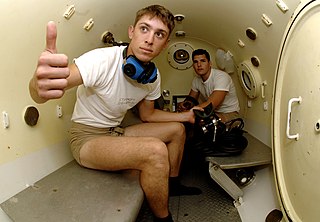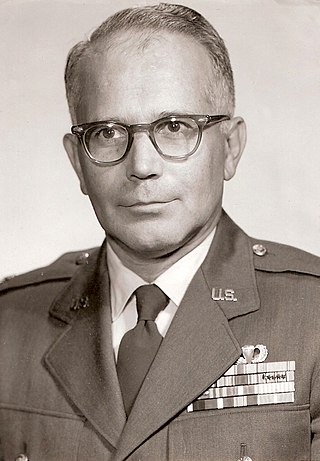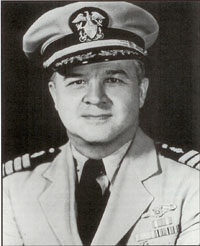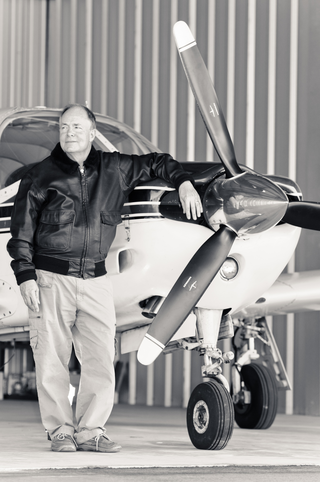
Diving medicine, also called undersea and hyperbaric medicine (UHB), is the diagnosis, treatment and prevention of conditions caused by humans entering the undersea environment. It includes the effects on the body of pressure on gases, the diagnosis and treatment of conditions caused by marine hazards and how relationships of a diver's fitness to dive affect a diver's safety. Diving medical practitioners are also expected to be competent in the examination of divers and potential divers to determine fitness to dive.
The Undersea and Hyperbaric Medical Society (UHMS) is an organization based in the US which supports research on matters of hyperbaric medicine and physiology, and provides a certificate of added qualification for physicians with an unrestricted license to practice medicine and for limited licensed practitioners, at the completion of the Program for Advanced Training in Hyperbaric Medicine. They support an extensive library and are a primary source of information for diving and hyperbaric medicine physiology worldwide.

Capt. Edward Deforest Thalmann, USN (ret.) was an American hyperbaric medicine specialist who was principally responsible for developing the current United States Navy dive tables for mixed-gas diving, which are based on his eponymous Thalmann Algorithm (VVAL18). At the time of his death, Thalmann was serving as assistant medical director of the Divers Alert Network (DAN) and an assistant clinical professor in anesthesiology at Duke University's Center for Hyperbaric Medicine and Environmental Physiology.
Arthur J. Bachrach was an American psychologist and administrator, who was Professor and Chairman of the Department of Psychology at Arizona State University, and Director of the Environmental Stress Program and Chair of Psychophysiology at the Naval Medical Research Institute at the Naval Medical Center in Bethesda.
In physiology, isobaric counterdiffusion (ICD) is the diffusion of different gases into and out of tissues while under a constant ambient pressure, after a change of gas composition, and the physiological effects of this phenomenon. The term inert gas counterdiffusion is sometimes used as a synonym, but can also be applied to situations where the ambient pressure changes. It has relevance in mixed gas diving and anesthesiology.

The United States Navy Experimental Diving Unit is the primary source of diving and hyperbaric operational guidance for the US Navy. It is located within the Naval Support Activity Panama City in Panama City Beach, Bay County, Florida.

Richard Rutkowski is a pioneer in the fields of hyperbaric medicine, diving medicine and diver training, especially in relation to the use of breathing gases.

Colonel William Paul Fife USAF (Ret) was a United States Air Force officer that first proved the feasibility for U.S. Air Force Security Service airborne Communications Intelligence (COMINT) collection and Fife is considered the "Father of Airborne Intercept". Fife was also a hyperbaric medicine specialist who was known for his pioneering research on pressurized environments ranging from high altitude to underwater habitats. Fife was a Professor Emeritus at Texas A&M University.

Captain Albert Richard Behnke Jr. USN (ret.) was an American physician, who was principally responsible for developing the U.S. Naval Medical Research Institute. Behnke separated the symptoms of Arterial Gas Embolism (AGE) from those of decompression sickness and suggested the use of oxygen in recompression therapy.
National Board of Diving and Hyperbaric Medical Technology (NBDHMT), formally known as the National Association of Diving Technicians, is a non-profit organization devoted to the education and certification of qualified personnel in the fields of diving and hyperbaric medicine.

Captain Charles Wesley Shilling was an American physician who was known as a leader in the field of undersea and hyperbaric medicine, research, and education. Shilling was widely recognized as an expert on deep sea diving, naval medicine, radiation biology, and submarine capabilities. In 1939, he was Senior Medical Officer in the rescue of the submarine U.S.S. Squalus.
The European Underwater and Baromedical Society (EUBS) is a primary source of information for diving and hyperbaric medicine physiology worldwide. The organization was initially formed as the European Underwater and Biomedical Society in 1971 and was an affiliate of the Undersea Medical Society for several years. Its purpose is promoting the advancement of diving and hyperbaric medicine and the education of those involved in the field; EUBS provides a forum and a journal for exchange of information and promotes research into diving medicine.

Robert William Hamilton Jr., known as Bill, was an American physiologist known for his work in hyperbaric physiology.

Eugene Weston Hobbs II, known as Gene Hobbs is an American technical diver and founding board member of the non-profit Rubicon Foundation. Hobbs has served as medical officer for the Woodville Karst Plain Project since 2004 and was named the 2010 Divers Alert Network/ Rolex Diver of the year. Hobbs was a hyperbaric technologist and simulation coordinator at Duke Medical Center before taking a position as the Director of Simulation for the University of North Carolina School of Medicine and Clinical Instructor in the Department of Pediatrics. As of 2018, Hobbs is the business manager for the UNC Health Care Department of Neurosurgery.

Neal Pollock is a Canadian academic and diver. Born in Edmonton, Canada he completed a bachelor's degree in zoology; the first three years at University of Alberta and the final year at the University of British Columbia. After completing a master's degree he then served as diving officer at University of British Columbia for almost five years. He then moved to Florida and completed a doctorate in exercise physiology/environmental physiology at Florida State University.
Richard Deimel Vann is an American academic and diver.

John R. Clarke is an American scientist, private pilot and author. He is currently the Scientific Director at the United States Navy Experimental Diving Unit (NEDU). Clarke is recognized as a leading authority on underwater breathing apparatus engineering.
Brian Andrew Hills, born 19 March 1934 in Cardiff, Wales, died 13 January 2006 in Brisbane, Queensland, was a physiologist who worked on decompression theory.










